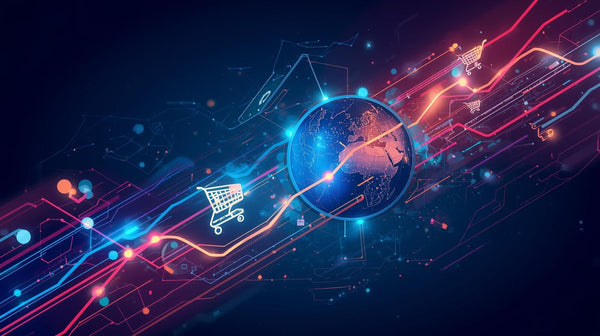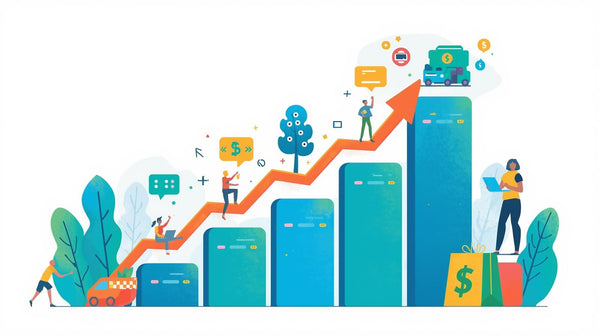Why Migrate from Fabric to Shopify: Performance, Simplicity, and Scale
Migrating from Fabric to Shopify is a strategic decision for modern brands that want to simplify operations, accelerate development, and boost performance. While Fabric offers modularity and flexibility through a headless architecture, it often comes with increased development time, higher infrastructure costs, and a fragmented ecosystem. Shopify, by contrast, offers a fully integrated, cloud-based commerce solution with built-in scalability, unmatched usability, and powerful features tailored to both DTC and B2B brands.
This comprehensive guide outlines why top brands are choosing to migrate from Fabric to Shopify. We’ll cover the most compelling reasons for the switch, unique SEO-friendly advantages of Shopify’s ecosystem, potential challenges to be aware of, and how EcomSpiders ensures a smooth, error-free migration experience from start to scale.
Why Brands Are Switching from Fabric to Shopify
While Commerce Layer offers flexibility through its headless architecture, many merchants eventually outgrow the platform’s dependence on custom development. Shopify delivers a complete, user-friendly ecosystem where developers and non-developers can collaborate efficiently. It significantly reduces reliance on third-party services, making it ideal for growing teams and brands.
Unique Advantages of Shopify Over Fabric
Making the switch to Shopify isn't just a platform update it's a business upgrade. For companies looking to scale, reduce technical maintenance, and empower their teams, Shopify offers unmatched advantages. It centralizes operations, enhances flexibility, and makes your entire commerce stack more accessible and agile. Whether you're looking for faster launch cycles or seamless app integrations, Shopify has the infrastructure to support long-term growth.
-
Lower Total Cost of Ownership: Shopify eliminates the need for separate hosting services, API maintenance, and dedicated frontend development teams.
Its fully hosted nature and streamlined architecture help businesses save significantly on infrastructure, dev resources, and ongoing support.-
No third-party hosting bills
-
Fewer dependencies reduce tech debt
-
Cost-effective for long-term growth
-
-
Faster Time to Market: Build and launch full-featured stores in days, not months. Shopify provides built-in tools and themes that let you go live faster without sacrificing quality.
-
Built-in Ecommerce Features: From cart to checkout, all essential tools are ready to go. Shopify comes pre-equipped with analytics, abandoned cart recovery, and multichannel selling options.
-
Easier Team Collaboration: Non-developers can manage content, inventory, and marketing. The intuitive admin interface empowers sales, marketing, and support teams to make updates without coding knowledge.
-
Reliable Hosting and Security: Shopify offers Level 1 PCI compliance and 99.99% uptime, ensuring your store is safe and always available to customers.
-
Community and Support Ecosystem: With a vast network of experts, partners, and documentation, Shopify makes it easy to find help when needed.
-
Lower Total Cost of Ownership: No need for separate hosting, APIs, or frontend development teams.
-
Faster Time to Market: Build and launch full-featured stores in days, not months.
-
Built-in Ecommerce Features: From cart to checkout, all essential tools are ready to go.
-
Easier Team Collaboration: Non-developers can manage content, inventory, and marketing.
How to Migrate from Commerce Layer to Shopify
The process of migrating from Commerce Layer to Shopify involves more than moving content it requires adapting architecture, rethinking integrations, and optimizing your store’s experience. At EcomSpiders, we guide you through each technical and strategic step, ensuring minimal disruption and maximum results.
Key Steps for a Successful Migration
A well-structured migration plan ensures your business stays online and optimized during the transition. EcomSpiders follows a meticulous step-by-step framework to move all essential data and frontend elements seamlessly.
-
Step 1: Audit and Planning
-
Review current architecture, APIs, and integrations.
-
Identify content, product catalogs, customer data, and order history to migrate.
-
-
Step 2: Shopify Setup
-
Select a Shopify plan and theme.
-
Configure store settings, shipping, taxes, and payment methods.
-
-
Step 3: Data Migration
-
Migrate structured data (SKUs, inventory, prices) and unstructured content (pages, blogs).
-
Map Commerce Layer endpoints to Shopify equivalents.
-
-
Step 4: Frontend Development
-
Recreate the storefront using Shopify themes or headless frameworks like Hydrogen.
-
-
Step 5: Testing and QA
-
Verify all data, design elements, checkout functionality, and SEO settings.
-
-
Step 6: Launch
-
Set up redirects, submit updated sitemap, and go live.
-
Why Shopify Outshines Fabric
Unified Platform for Everything
Shopify combines hosting, security, CMS, and marketing tools into a single, cohesive platform. This eliminates the need for multiple vendors and reduces the friction of managing your business.
-
No need for separate CMS, CDN, or hosting.
-
Central dashboard to manage all store operations.
-
Streamlined operations save time and reduce complexity.
Shopify includes everything you need for ecommerce success, from hosting and security to marketing and analytics. -
No need for separate CMS, CDN, or hosting.
-
Central dashboard to manage all store operations.
Built for Business Users, Not Just Developers
Shopify was built for entrepreneurs and marketers not just developers. Anyone on your team can make updates, manage promotions, or launch products without writing code.
-
Drag-and-drop interface for page building.
-
Content management without developer bottlenecks.
-
Ideal for growing teams with limited technical resources.
Shopify empowers marketing, content, and sales teams to operate independently. -
Drag-and-drop interface for page building.
-
Content management without developer bottlenecks.
Ecosystem Advantage: Apps and Extensions
The Shopify App Store gives you access to thousands of tools that can improve operations, customer engagement, and sales. These apps are vetted for quality and integrate seamlessly.
-
Faster time to value with plug-and-play apps.
-
Vetted for quality and security.
-
Apps for SEO, loyalty, subscriptions, analytics, and more.
Choose from 8,000+ apps for subscriptions, loyalty, SEO, payments, and more. -
Faster time to value with plug-and-play apps.
-
Vetted for quality and security.
Checkout Experience That Converts
Shopify’s checkout is engineered to maximize conversions with speed, trust, and multiple payment options. It adapts to various geographies and device types.
-
One-click checkout with Shop Pay.
-
Integrated fraud detection and localized payment methods.
-
Streamlined user experience across devices.
Shopify offers industry-leading checkout experiences that boost conversion rates. -
One-click checkout with Shop Pay.
-
Integrated fraud detection and localized payment methods.
Scale with Confidence, No Extra Overhead
Whether you run a boutique store or a global brand, Shopify adapts to your needs. You get all the tools for scale without the need for constant development support.
-
Auto-scaling infrastructure.
-
Enterprise-ready features with Shopify Plus.
-
High availability and peak performance support.
Shopify powers startups and enterprise brands alike. -
Auto-scaling infrastructure.
-
Enterprise-ready features with Shopify Plus.
Common Pitfalls When Migrating from Fabric to Shopify
Migrating from Commerce Layer to Shopify can involve several challenges, especially for businesses using complex headless setups or custom APIs. However, understanding these challenges beforehand and working with an expert team can significantly reduce risks and ensure a smoother transition. Below are key challenges to be aware of, each with potential solutions and expert insights.
API Mapping and Data Structure Differences
Commerce Layer is deeply API-centric and requires a different approach to data management than Shopify. Mapping these APIs to Shopify's native schema can be intricate.
-
Shopify's data model may not support all the custom logic used in Commerce Layer.
-
Custom attributes, nested categories, or multi-language setups may require additional customization.
-
Automated tools can help, but expert oversight is necessary for accuracy.
Migrating a Headless Architecture to Shopify
Commerce Layer is designed for headless flexibility, while Shopify is more opinionated in structure. Adapting a fully headless build into Shopify—especially without losing performance takes architectural planning.
-
Hydrogen, Shopify's headless solution, may still require a rework of frontend logic.
-
Performance tuning, SEO implementation, and dynamic content rendering should be planned early.
-
Data fetching models may differ, affecting your site's responsiveness.
Preserving SEO and URL Structures
Maintaining SEO rankings during a migration is critical. Shopify uses a different URL structure than many custom headless sites.
-
Redirects must be carefully implemented using 301s.
-
Metadata, canonical URLs, alt tags, and schema must be audited and reconfigured.
-
Failure to address SEO at launch may result in a temporary drop in traffic.
Rebuilding Frontend UI/UX
Headless platforms like Commerce Layer often rely on React/Vue custom frontends. Rebuilding this in Shopify requires design realignment and UX considerations.
-
Shopify themes can be customized, but exact replication of headless features may need Liquid or React development.
-
Responsive design, accessibility, and UI flow should be reassessed in Shopify context.
-
It’s a chance to optimize for mobile-first performance and improved usability.
App and Integration Gaps
Some third-party integrations used with Commerce Layer may not have direct Shopify counterparts.
-
You may need to replace or rebuild certain apps and integrations.
-
Shopify’s app store covers many common needs, but not all headless tools have equivalents.
-
Custom development or API bridging may be necessary.
Team Re-Training and Workflow Adjustment
Shifting from Commerce Layer's developer-first approach to Shopify's merchant-focused UI means your team will need to adapt.
-
Staff will need training on the Shopify admin interface and app usage.
-
Backend and frontend workflows may change significantly.
-
Investing in onboarding ensures smoother internal adoption post-migration.
Understanding potential issues in advance can save significant time and money. At EcomSpiders, we proactively solve these problems to ensure a seamless migration.
-
API Mapping Complexity: Mapping Commerce Layer APIs to Shopify's structure requires care.
The two platforms have fundamentally different data structures, requiring careful mapping and often custom middleware. Shopify’s predefined schemas may limit some flexibility but simplify long-term maintenance.-
Requires expert oversight to ensure relational data integrity
-
Can delay timelines if undocumented APIs exist
-
May need custom scripts or middleware tools
-
-
Headless Architecture Adaptation: Shopify supports headless, but may require changes in data flow.
Migrating a fully decoupled frontend built with React, Vue, or other frameworks often requires changes in API behavior, rendering logic, and performance optimization strategies.-
Hydrogen and Oxygen provide options but aren't plug-and-play
-
Requires performance benchmarking post-launch
-
SEO and user experience must be tested thoroughly
-
-
Content Porting: Static content and dynamic modules may need manual recreation.
Shopify's CMS handles content differently than Commerce Layer. Complex layouts, headless-driven pages, or custom frontend modules will require reimplementation using Shopify themes or third-party builders.-
Custom layouts may need to be recreated using Liquid or Shopify apps
-
Blog, landing pages, and collections may require manual refinement
-
Dynamic content must be QA-tested for mobile and SEO friendliness
-
Why Partner with EcomSpiders for Your Shopify Migration
Our team at EcomSpiders brings hands-on experience in transitioning brands from headless and API-driven platforms like Commerce Layer to Shopify’s robust ecosystem. We tailor every aspect of the migration to your business goals, combining technical accuracy with creative design and marketing expertise.
What We Offer:
We provide end-to-end Shopify migration services designed to support your store before, during, and after launch. Our team works closely with clients to reduce friction and create a seamless experience that matches your business objectives. Whether you're moving from a fully headless setup or a hybrid system, we tailor our solutions to your specific operational needs.
We provide end-to-end Shopify migration services designed to support your store before, during, and after launch. Our process is hands-on, tailored, and performance-driven. We understand that each business is different, so we provide scalable, modular services to meet your goals. Whether you're looking to completely redesign your store or simply move your catalog and content with minimal disruption, EcomSpiders has the expertise to execute with precision.
-
Complete Data Migration: We migrate your entire Commerce Layer data ecosystem including products, collections, inventory, customers, and historical orders accurately and securely.
-
Structured data validation and mapping
-
Historical order syncing
-
Secure import/export workflows
-
-
Custom Shopify Themes: Our creative team builds unique Shopify themes that match your brand aesthetics while focusing on improving user experience and conversions.
-
UX-focused wireframing and prototyping
-
Brand-consistent responsive design
-
Conversion-optimized layouts
-
-
Headless and Hydrogen Support: If you’re already using headless architecture, we help integrate Shopify’s headless solutions like Hydrogen and Oxygen with flexibility and performance.
-
Integration of custom APIs with Hydrogen frontend
-
Performance benchmarking and improvements
-
Server-side rendering where needed
-
-
SEO Strategy and Redirects: From 301 redirects to canonical URLs and metadata optimization, we implement a robust SEO plan to preserve and enhance your search engine rankings.
-
Technical SEO audits and metadata restructuring
-
Redirect mapping and implementation
-
Structured data/schema configuration
-
-
Post-Migration Training and Support: We empower your in-house teams with hands-on training, detailed documentation, and ongoing technical support so you can manage your Shopify store confidently.
-
Team onboarding workshops
-
Role-specific documentation
-
Slack/email access to Shopify experts
-
-
App Recommendations and Setup: We recommend and configure the best-fit Shopify apps to extend your store’s functionality, whether it’s for shipping, marketing, subscriptions, or analytics.
-
Vetting of top-performing apps by use case
-
Installation and configuration
-
Usage training and reporting setup
-
-
Performance and Speed Optimization: Our technical experts fine-tune your Shopify store for fast load times, mobile responsiveness, and overall performance efficiency.
-
Asset minification and lazy loading
-
Mobile-first testing and fixes
-
Real-user performance tracking
-
-
Analytics and Conversion Tracking: We set up advanced tracking with GA4, Meta Pixel, and conversion APIs to help you make data-driven decisions post-launch.
-
Shopify-integrated GA4 event mapping
-
Meta Pixel optimization for custom events
-
Setup of reporting dashboards
-
Ready to Migrate from Commerce Layer to Shopify?
By choosing Shopify, you're not just selecting a platform you're choosing a partner in growth, flexibility, and future-readiness. With Shopify’s intuitive tools and EcomSpiders’ end-to-end migration services, your brand will be well-positioned to scale efficiently and exceed customer expectations.
Migrating doesn’t have to be stressful or risky. EcomSpiders can help you unlock the power of Shopify with a seamless transition that preserves your brand, boosts performance, and fuels future growth.
Book your free migration consultation today and take the first step toward a smarter commerce future.





0 comments